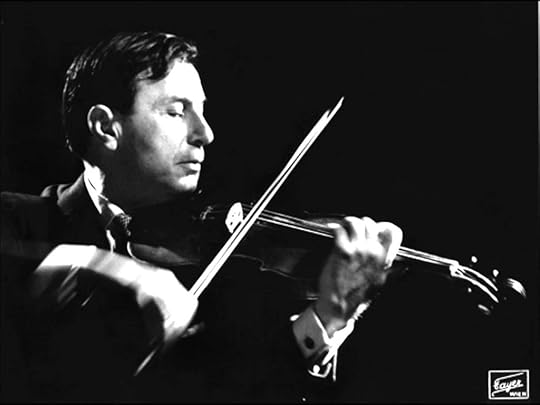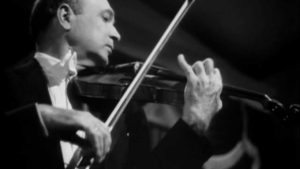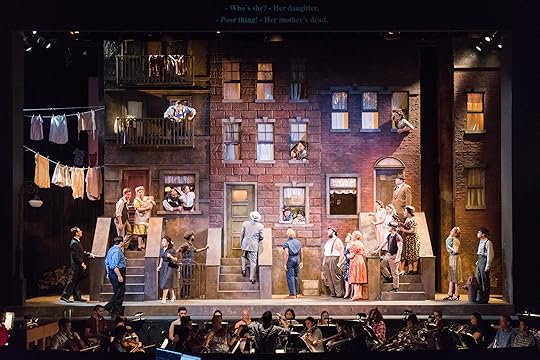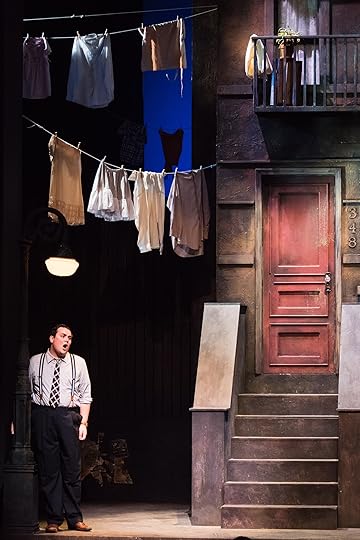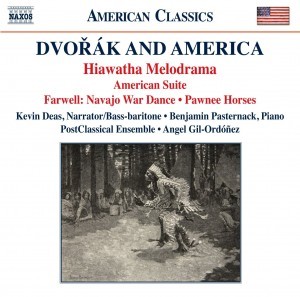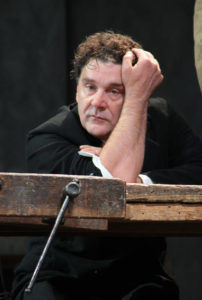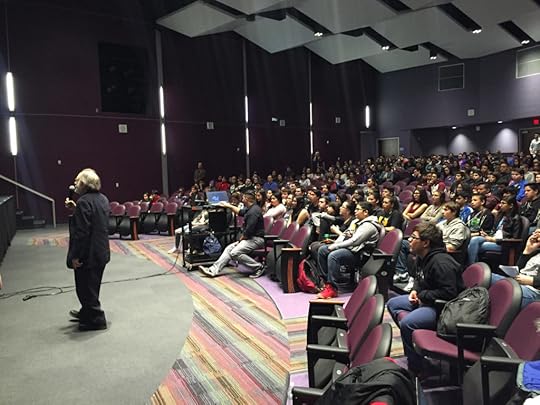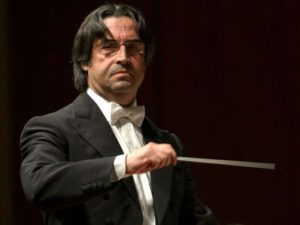Joseph Horowitz's Blog, page 28
August 6, 2017
Milstein vs. Szigeti
My frustrations with a recent performance of Brahms’ Violin Concerto sent me to youtube in search of something different: an act of therapy.
A foible to which violinists are prone (pianists are immune) is lingering upon or otherwise savoring a beautiful note. That’s OK in Bruch or Tchaikovsky but does no favors to Brahms or Beethoven.
After half an hour of Menuhin, Heifetz, Milstein, of Furtwangler, Toscanini, and Klemperer, I discovered a Brahms concerto beyond any I’d ever encountered: Joseph Szigeti (the second of my photos) in live performance with Dimitri Mitropoulos and the New York Philharmonic in 1948. Mitropoulos’s orchestra is incendiary. Szigeti’s rubatos are dictated by musical structure, not sonic allure. He never lingers on the beauty of a note because his sound is never beautiful. It slavishly serves the keenest possible musical intelligence.
Listen to Szigeti and Mitropoulos ignite at 12:20, surging toward the first-movement recapitulation of this historic performance. Or listen to how Szigeti’s rounds off his cadenza to prepare the first movement coda. The ensuing prolonged ovation – from a Carnegie Hall audience that knew it wasn’t supposed to clap midway through a concerto – isn’t about violin playing.
I have never heard a violinist sing the second movement less prettily or more tellingly. The eloquence of Szigeti’s song is a function of phrasing and accentuation, not timbre or polish. This entire Adagio is galvanized by a binding trajectory. There is not a single indulgent rubato or rallentando. The performers make the strongest possible case for the music at hand. Forget about rote “textual fidelity” – this proactive interpretation is as authentic as it gets.
For beautiful violin playing Milstein is my man. I have long considered his 1963 recording of Saint-Saens’ Third Violin Concerto the most seductive violin playing documented in sound. So after binging on Brahms I returned to that recording – on youtube – for the first time in many years.
I also discovered Milstein in Chausson’s Poeme – a revelation. He takes the soaring airborne central Anime at a clip so fast the affect is astral.
I wrote about Milstein long ago – in 1993, when EMI commemorated his death with a two-CD box celebrating “The Art of Nathan Milstein.” That New York Times article is re-printed in my 1995 essay collection The Post-Classical Predicament. I can’t improve on my encomium. Here’s part of what I wrote:
“Milstein’s violin was worldliness itself. He never forced or varnished his slender, silvery tone. He shunned the urgent vibrato of his onetime classmate Jascha Heifetz. He disdained what Virgil Thomson called the ‘wow effect.’ At top speed, his passagework was easy, clear, never out of breath. In every aspect of interpretation, he eschewed exaggeration. His very appearance, dapper and composed, was not debonair, but simply and unaffectedly aristocratic. . . .
“Of Camille Saint-Saens it was quipped that he possessed all the attributes of a great composer save innocence; he was incurably, imperturbably urbane. Milstein’s 1963 recording of Saint-Saens’s Third Concerto . . . is without doubt one of the most beautiful ever made by a violinist.
“A performance more earnest than Milstein’s would make this music sound sentimental. A more brilliant performance – from a less transcendental instrumentalist, incapable of Milstein’s composure under fire – would make it sound trite. The vehemence of the concerto’s opening Allegro, the intoxication of its luminous swaying slow movement, the elan and manque religiosity of its tarantella-and-chorale finale – all, in Milstein’s hands, are poised, but perfectly, between passion and refinement. The result is transformative: an exercise in elegance and craftsmanship become sublime.”
I first encountered this recording at the Upper West Side apartment of my friend Solomon Volkov, who had co-authored Milstein’s autobiography. Solomon played for me the second subject of the first movement. That’s at 2:40. The calm fluidity of this passage, juxtaposed with a window view of the Manhattan sky with Broadway far below, made an uncanny impression I will never forget.
Some years later I met Milstein’s last accompanist, Georges Pludermacher. When I shared with him my admiration for the Saint-Saens performance, he told me that it had been Milstein’s favorite recording (notwithstanding some insecurity in the opening solo, which he regretted).
I happened to attend – both in rehearsal and performance, what I believe were Milstein’s final concerto performances – of the Bruch Gminor with Gerard Schwarz and New York’s Y Chamber Symphony. I experienced the startling quietude of the opening solo as a rebuke to my generic expectations.
Milstein reportedly said that he loved the violin more than music itself – a touching confession. Of Szigeti it was self-evident that music and not the fiddle was his first love. They are great antipodes of the violin.
July 30, 2017
Kurt Weill in 2017
“Wherever I found decency and humanity in the world, it reminded me of America.” That this observation – recorded by Kurt Weill in 1947 – rings hollow in 2017 does not diminish the fascination and pertinence of Weill’s extraordinary creative saga, perhaps the most elusive charted by any major composer.
In Berlin, Weill’s caustic signature was The Threepenny Opera, created with Bertolt Brecht in 1928. Seven years later he landed in the US, a Jewish refugee from Hitler’s Germany. During the fifteen years of his American career – he died of a heart attack in 1950, age 50 – not a single one of his European stage works was given a professional American production. He had instead become a leading Broadway composer whose two smash hits were Lady in the Dark and One Touch of Venus. He had also become a patriotic American who told Time Magazine: “Americans seem to be ashamed to appreciate things here. I’m not.”
Weill’s European/American odyssey was explored in copious detail during this summer’s Brevard Music Festival. Not the least exceptional component of this festival-with-a festival was Brevard’s inquisitive audience. “Was Weill Panglossian?” Bob Wilkinson, a retired airplane pilot who came to everything, wanted to know. The response – during a two-day Kurt Weill symposium – led to the Red Scare and the conjecture that, had he lived a few more years, Weill might have been subpoenaed by Joseph McCarthy and asked a few questions. Could Weill have reconsidered the popular American audience he had courted, as did Aaron Copland? We will never know.
The Brevard festival incorporated ten events over a period of five weeks. Audiences could compare The Seven Deadly Sins, which Weill considered his finest achievement as of 1933, with Street Scene, the 1947 Broadway opera he believed would be his most important legacy. There was a full program of obscure “early Weill.” An evening juxtaposing Weill and Arnold Schoenberg presented antithetical musical responses to Pearl Harbor. A generous sampling of Weill’s Broadway fare was one of two events incorporating a continuous visual track. The other was a “cabaret” – “Change the World, It Needs It!” – exploring the tangled relationship between Weill, Brecht, and Marc Blitzstein, all of whom pursued art as an instrument of social or political change. “Change the World” ignited a one-hour post-concert discussion; one respondent called it “a call to action.”
The Brevard Weill festival was both an act of advocacy supported by the Kurt Weill Foundation, and an adventure in contextualized programing supported by the National Endowment of the Humanities’ Music Unwound project (of which I’m the director). Concurrently this summer, the New Hampshire Music Festival presented a Music Unwound “Copland and Mexico” festival – another look at music and politics. Both the Brevard and New Hampshire festival audiences are weighted with retirees from the big city – which is to say, people of a certain age who grew up reading books and now have plenty of time to pursue their cultural interests. I was left with an uneasy feeling that the older the audience, the better.
The performers at Brevard included two supreme singing actors – Lisa Vroman, who brought down the house with The Seven Deadly Sins, and Bill Sharp, who brought down the house (I kid you not) with Schoenberg’s 12-tone Ode to Napoleon, which musically rages at Hitler as only Schoenberg could. The festival also boasts three orchestras, a world-class artistic director (Keith Lockhart), a fearless artistic administrator (Jason Posnock), and a ridiculously accomplished student opera company.
Weill’s Broadway opera Street Scene, with a cast of 50 (I include Mrs. Jones’s dog), was the festival climax. This day-in-the-life of a 1920s Manhattan apartment block depicts the American Melting Pot and probes the American Dream. It originated as a 1929, Pulitzer-Prize winning play of the same title by Elmer Rice – a view from the left of fraught aspiration and frustration. In 1947, the national mood was sunnier, and Street Scene the opera – for which Rice and Weill were joined by Langston Hughes – acquires a subliminal New World glow notwithstanding the hard lives under review. It retains topicality but the topics have shifted. There was a chill in the house when Frank Maurrant, a stagehand discomfited by the immigrant melee, sang his aria “Let things be like they always was. That’s good enough for me!”
Dean Anthony, who heads Brevard’s Janiac Opera Company, was once a widely experienced comprimario tenor – which is to say that (unlike some others one could name) he’s an opera director who is both theatrically and musically literate. He also happens to have participated (as Mr. Buchanan) in the best-known of all Street Scene revivals – the one directed in Berlin (and elsewhere) by Francesca Zambello. As amazing as I’ve found Dean’s work with Brevard student vocalists in previous summers, directing Weill he has surpassed himself.
The excellence of the Brevard Street Scene began with a stunning physical production, designed and built in-house (top of this blog).
As most of the characters in the drama are ethnic types, they easily become cartoons. And yet they must register quickly and vividly to clinch the neighborhood’s melting-pot diversity. The Brevard production flawlessly negotiated this fine line. Each participant was accorded a repertoire of detailed gesture and expression. But the result was not glib or shallow.
The staging of Sam Kaplan’s arioso “Lonely House,” in some ways a theme-song for the opera, encapsulated the ingenuity of the whole. Sam, who dreams of law school and other bigger things, is confiding frustration and estrangement. His song ends as hopelessly as it began: “I’m lonely in this lonely house/in this lonely town.” In the Brevard production, Sam (Taylor Rawley) is leaning on a lamp post.
Dean has him take a breath after “lonely” and sticks a fermata (a hold) on “town.” Sam turns from the audience and sustains a diminuendo on this long E-flat as he walks slowly out of the lamp’s sad pool of light and disappears into darkness. Had he remained in place for applause, the poignancy of the moment could only diminish. And the transition to the next episode – a “scene and song” in another key entirely – could only jar.
(Opera is an integrated artform. Here and elsewhere, Dean worked hand-in-glove with his superb conductor, Robert Moody.)
I also had occasion to watch Dean Anthony coach “Glitter and Be Gay,” the coloratura showpiece from Leonard Bernstein’s Candide. This was part of a daily opera workshop he calls “movement.” Vocal and dramatic insights are seamlessly wed. As Bernstein’s inebriated Cunegonde, collapsed into the crook of a piano, Dean was both hilarious and true; he topped and transcended camp. He directs Candide at Brevard next summer as part of a Bernstein Centenary celebration that will also broach the Red Scare, Young People’s Concerts, and sundry other topics. This festival will not be NEH-supported. Rather, it documents the longterm impact of Music Unwound at Brevard. In the wake of last summer’s Music Unwound “Dvorak and America” festival, and this summer’s Weill activities, Brevard has become the only major American summer music festival/training institute to embrace humanities-infused pedagogy and programming: thematic immersion experiences.
Meanwhile, Music Unwound will take “Kurt Weill’s America” to El Paso via the El Paso Symphony and the University of Texas at El Paso; to Sioux Falls via the South Dakota Symphony; to Raleigh and Chapel Hill via the North Carolina Symphony and UNC; and to Buffalo via the Buffalo Philharmonic. I have no doubt that Weill’s saga of immigration and assimilation will prove freshly pertinent many times over.
(Photos by Bobby Bradley)
July 15, 2017
New Musical Venues for a New National Moment
With classical music under siege, many are rethinking audiences and venues. Here in Manhattan, Geffen Hall – previously Fisher Hall, and before that Philharmonic Hall – has never been an inviting place in which to hear music. The acoustics are defective, the ambience is nothing special. One cannot blame the hall for the New York Philharmonic’s disengaged audience – but it’s a factor. At Carnegie Hall, ten blocks downtown, a community of listeners is joined on special occasions by distinguished ghosts seduced by echoes of a hallowed past.
PostClassical Ensemble – the DC chamber orchestra I co-founded 14 years ago – has at all times been without a special home, even an adequate home. Our concerts are thematic and sui generis. We incorporate film, dance, or theater. We don’t fit comfortably in a concert hall.
Last season PCE was invited by the Washington National Cathedral to produce “The Trumpet Shall Sound” – a concert intermingling spirituals and religious arias, all sung by the inspirational bass-baritone Kevin Deas. The Cathedral Choir – a superb professional chorus – took part, as did dozens of DC high school choristers. The main nave – a towering, aspirant spiritual corridor — was full. The audience was inter-racial. The music impacted in ways no concert hall could possibly have fostered.
PCE was subsequently invited by Mike McCarthy, the Cathedral’s music director, to become an Ensemble-in-Residence. Mike is a man with a mission and it aligns with ours: to explore music as an instrument for human betterment. Addressing PCE’s new residency, he commented:
“Washington National Cathedral is one of the finest examples of devotional art in the world. It stands testament to mankind’s yearning to see the perfection of beauty on earth. It allows us to glimpse a portal through which we can experience the divine. In such an environment music plays a crucial role, amplified by inspirational surroundings. It is both a cultural legacy that we have inherited and cherish, and a means for responding to the world and its challenges.”
Our initial season of concerts at the National Cathedral comprises “Music in Wartime,” a Pearl Harbor Day commemoration; “Deep River – The Art of the Spiritual,” a Harry Burleigh celebration; and “Secret Skirmishes of the Cold War: The Shostakovich Case,” a reconsideration of the CIA’s cultural Cold War.
The first of these events will begin with one of Hanns Eisler’s workers’ songs performed as a processional. The second will end with “Goin’ Home” as a spacial experience. The third will include an actor performing as John F. Kennedy. For 2018-19 we are planning a mega-event which will empty the nave of pews and incorporate lighting design. The Cathedral also offers a multitude of smaller spaces ideal for art installations, and for lectures and discussion.
At a national moment when art for art’s sake seems increasingly irrelevant, the Washington National Cathedral seems newly pertinent to art.
July 3, 2017
Rethinking “Classical Radio”
When commercial radio was new, the airwaves were saturated with classical music – not just recordings and live concerts, but highly produced pedagogical programs. You could tune into Abram Chasins for tips on playing Chopin’s E-flat major Nocturne.
What today passes for classical music radio is a different species of broadcasting. You can spend an afternoon listening to the 50 greatest hits (scientifically culled) in their latest, most generic studio incarnations. Older recordings are shunned. Talking is avoided as a plague upon the listener.
A fellow named David Osenberg has courageously crafted an alternative template. It’s called WWFM Classical Radio and anyone can tune in anytime because it’s streamed internationally. At Dave’s invitation, PostClassical Ensemble now has its own “PostClassical” series on WWFM. These two-hour shows are nationally unique. They’re thematic. They’re crammed with commentary – not just knowledge and opinion, but learned debate. The three participants – myself, PCE Music Director Angel Gil-Ordondez, and host Bill McGlaughlin – are frequently flying in different directions. And Bill – who comes to radio as a conductor and musical advocate of long experience – is additionally prone to personal anecdotes and historical digressions that temper my obsessive harangues.
We began with a show challenging Ricardo Muti’s assertion that orchestras are better than ever, sampling amazing recordings from the thirties and forties, when orchestras were better than now.
Then came our Lou Harrison Centenary tribute.
The latest installment, just up, is “Dvorak and Hiawatha.” Like the Harrison show, it features PCE recordings for Naxos – which, like WWFM, enthusiastically supports our attempts to do everything differently.
I believe “Dvorak and Hiawatha” has to be one of the most provocative treatments of American music ever aired on American radio. My premise – which Angel supports and Bill resists – is that Dvorak became an “American composer.” Is the New World Symphony directly inspired by Longfellow’s The Song of Hiawatha? Does it end with a dirge signifying Hiawatha’s departure into “the purple mists of evening”? Angel and I think so. Bill isn’t so sure. He sees Aaron Copland as an heir to Dvorak. Not I; Copland balked at using the “Negro melodies” Dvorak adored. A truer heir, to my way of thinking, was George Gershwin. Or the American Bartok: Arthur Farwell.
Our shows spill beyond the allotted two hours. But Dave posts everything. Here’s a Listening Guide for “Dvorak and Hiawatha”:
Part I: THE HIAWATHA MELODRAMA
7:00 – How the Dance of Pau-Puk Keewis inspired the Scherzo from Dvorak’s New World Symphony
12:30 – Why does Dvorak’s symphony end with a dirge? Hiawatha’s Departure
17:50 – The Larghetto from Dvorak’s Violin Sonatina as a picture of Minnehaha and Minnehaha Falls
26:10 – Dvorak’s American Suite and his Indianist mode
33:00 – The complete Hiawatha Melodrama, with Kevin Deas and PostClassical Ensemble conducted by Angel Gil-Ordonez, on PCE’s Naxos “Dvorak and America” CD
Part II: DVORAK’S AMERICAN SUITE
4:25 – Does the opening evoke Jerome Kern?
5:40 – The second movement’s “plantation song”
8:20 – The third movement’s minstrel dance, plantation song, and Indian elegy
12:20 – What defines Dvorak’s Indianist trope?
13:13 – How an Indian dance becomes a minstrel song in the finale
15:35 – Why this is not “program music”
17:35 – The complete American Suite, performed by pianist Benjamin Pasternack on PCE’s Naxos “Dvorak and America” CD
39:00 – Why is Dvorak’s “American style” more than an “American accent”?
40:02 – The Dvorak Humoresques in G-flat and F major (sounds like Gershwin), with pianist Benjamin Pasternack
53:00 – Dvorak vs Aaron Copland – why Gershwin is the real heir to Dvorak
Part III: THE AMERICAN BARTOK: ARTHUR FARWELL
00:50 – Farwell’s Indian War Dance No. 2, performed by Benjamin Pasternack
6:06 – Farwell’s “Pawnee Horses,” in versions for piano (Benjamin Pasternack) and 16-part a cappella chorus (The University of Texas Chamber Singers conducted by James Morrow)
17:00 – Dvorak/Fisher: “Goin’ Home,” sung by Kevin Deas with PCE conducted by Angel Gil-Ordonez
TO PURCHASE PCE’S “DVORAK AND AMERICA” ON NAXOS: click here
TO LEARN MORE ABOUT DVORAK AND AMERICA: click here
June 17, 2017
Uncle Vanya Meets Porgy and Bess
What did the legendary Russian experimental theater director Yevgeny Vakhtangov (1883-1922) have in common with Porgy and Bess, Oklahoma!, and Carousel? The immigrant director of these landmark Broadway productions, Rouben Mamoulian, was to some degree a Vakhtangov disciple.
Mamoulian took Broadway by storm in 1927 with his staging of Dubose Heyward’s novel Porgy. At the age of 30, he was an overnight star, an apostle of radically integrated musical theater imposed by a singular directorial vision. Mamoulian’s fame drove him to Hollywood, where he hired Richard Rodgers to through-compose music for Love Me Tonight (1932) – a supreme musical film that subverts and surpasses Ernst’s Lubitsch’s film musicals. It may be plausibly inferred that Mamoulian introduced Rodgers to the strategies and ideals that would make Oklahoma! and Carousel Broadway break-throughs. In short: Mamoulian is a forgotten hero of American musical theater – and the influence of Russian experimental theater on mainstream Broadway is a story even more forgotten.
I became aware of the magnitude of Mamoulian when writing Artists in Exile: How Refugees from European War and Revolution Transformed the American Performing Arts (2008). Subsequently, I plundered the Mamoulian Archive at the Library of Congress and discovered that Mamoulian’s impact on Porgy and Bess was more fundamental than anyone had imagined. He single-handedly turned Heyward’s novel into a musical redemption drama (Porgy the play was already full of singing) eschewing Heyward’s efforts to “authentically” represent the African-American Gullahs of Charleston’s Catfish Row. (I reported these findings in “On My Way” — The Untold Story of Rouben Mamoulian, George Gershwin, and “Porgy and Bess.”)
How indebted was Mamoulian to Vakhtangov? It’s an elusive topic because Mamoulian preferred to present himself to Americans as a self-created genius. And yet descriptions of the Vakhtangov studio – of which Mamoulian was part sometime during his Moscow years 1915-1918 – fit the Mamoulian mold. Vakhtangov was a Stanislavski disciple who rejected Stanislavski’s verisimilitude. Rather, he espoused “fantastic realism” wedded to “total theater.” Like Stanislavski, he cultivated an aesthetically bonded community of actors. Unlike Stanislavski, he was obsessed with choreographing sound and music – with rhythm and tempo. His detractors complained of a surfeit of detail, of elaborate artifice and a failure to project interior feeling. All of this fits Mamoulian – especially his hyper-ambitious Porgy and Porgy and Bess productions, preceding a long and erratic decline accelerated by the influence of Hollywood and a bad marriage.
A century later, Moscow’s Vakhtangov Theater endures. Rimas Tuminas, its Lithuanian artistic director since 2007, is today a reckonable force in Russian theater. His award-winning Vakhtangov production of Chekhov’s Uncle Vanya, first given in Moscow in 2009, is currently enjoying a short run at New York’s City Center. To what degree Tuminas’s Vakhtangov Theatre retains the imprint of Yevgeny Vakhtangov I have no idea. But this Vanya seems to fit the bill. It rejects verisimilitude. It embraces total theater and a consuming directorial vision (what we today call Regietheatre). And, most strikingly, it integrates music more pervasively than any production I have ever encountered of a classic play.
In fact, a musical score composed by Fautus Latenas is a constant ingredient. Latenas has supplied a series of minimalist mood vignettes, each a short refrain incessantly repeated. The volume is usually low, but there are also crescendos and climaxes aligned with Chekhov’s text. This could be a recipe for kitsch if the score were deployed to underpin the mood on stage. But that mood is polyvalent, and more often than not the musical component is ironic. Sonia’s excrutiating scene with Dr. Astrov, for instance, is played to a tart waltz.
In a useful interview in the City Center program book, Tuminas says:
“Chekhov looked at people’s desire to be happy and thought, ‘My god, you are so funny! You daydream and expect happiness, knowing full well that it’s impossible!’ He sees all these poor, holy crearures who want something and are reaching for something even though there’s nothing up ahead, and it makes him smile a kind, forgiving smile. That’s probably why there’s so much humor in his plays. It’s deeply hidden, but if we can grasp it, perhaps we’ll understand something important about our own lives.”
I would not call the humor in Tuminas’s Uncle Vanya “deeply hidden.” Sergey Makovetskiy, who plays Vanya (in the photo above), is virtuoso mime. Limping and disheveled, ill-attuned to life’s requirements, he projects the pathos of a W. C. Fields or Buster Keaton. A reading more distant from Michael Redgrave’s famous English-language Vanya is scarcely imaginable. At the play’s beginning, the news of the Professor’s arrival animates Vanya hilariously. The pompous formality of the entrance itself, accompanied by a fawning retinue, equally invites laughter. But this tone is not sustained. The contradictory vectors dialectically at play – humor vs. pathos, music vs. action, attraction vs. repulsion among the variegated dramatis personae of the Serebryakov estate – are at all times exquisitely unpredictable.
The Professor himself is cast against type. Vladimir Siminov is a big, robust actor whose credits include Othello and Pushkin’s Boris Godunov. His Aleksandr Vladimirovich is surprisingly libidinous but sufficiently preposterous. Sonya, Eugenia Krehzhde, is a gamin whose credits include Tatyana in Eugene Onegin. Neither she nor Makovetskiy’s Vanya could credibly run a rural Russian estate.
The elusive affect of this production is not the concentrated bittersweet aura we know as “Chekhov” – and whose aching vacancy is supported by silence, not music. I thought the use of the Hebrew prayer “Kol nidre” (played by a solo trumpet) as a type of theme-song was a miscalculation – it does not invite submissive repetition under the dialogue. Otherwise, I found the production engaging at one or another level at every unforeseen twist and turn.
In Rouben Mamoulian’s 1935 Porgy and Bess, “I got plenty o’ nuttin’” was accompanied by a set of empty rocking chairs moving to and fro in time with Porgy’s song, as were the needles of women sewing. In Tuminas’s Uncle Vanya, pre-recorded musical cues precisely dictate the timing of a spoken phrase. What any of this may have to do with the legacy of Yevgeny Vakhtangov remains a tantalizing question.
May 2, 2017
The Lou Harrison Centenary
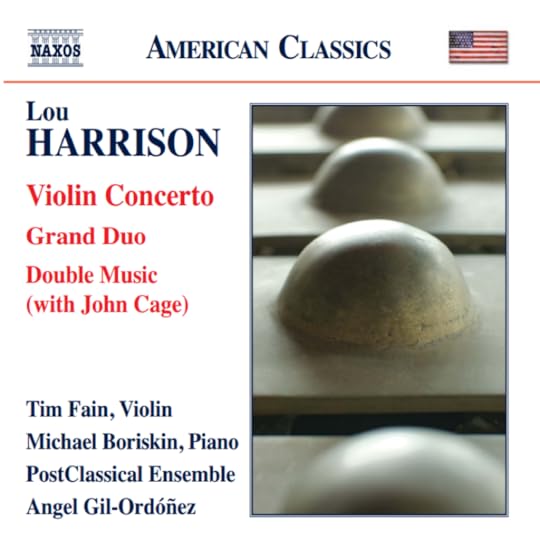
If you asked me who composed the best American violin concerto, and who composed the best American piano concerto, I would answer with the same name: Lou Harrison.
And yet, except on the West Coast of the United States, Harrison is not a brand name. The present Harrison Centenary year can help to change that. We finally have a copious full-scale biography: Lou Harrison: American Musical Maverick by Bill Alves and Brett Campbell. Alex Ross, our most necessary observer of American classical music, has published a brief but telling Harrison encomium in The New Yorker. And PostClassical Ensemble has contributed a new Naxos CD with two of Harrison’s most important works: the aforementioned Concerto for Violin and Percussion, and the Grand Duo for violin and piano.
Last week, PCE launched our new CD with a Harrison concert at the Indonesian Embassy in DC (a Harrison mecca thanks to Ambassador Budi Bowoleksono). Both the CD and the concert (and also Ambassador Bowoleksono) are represented in the second installment of our “PostClassical” radio series on the indispensable WWFM Classical Network. You can access this two-hour tribute, hosted by Bill McGlaughlin, Angel Gil-Ordonez, and myself, right here.
To listen to the Violin Concerto, in a torrid performance by Tim Fain with Angel and PCE, just fast-forward to 18:35 of Part I.
Harrison invented the percussion ensemble with John Cage and Henry Cowell. With Cage, he plundered junkyards and import stores in search of new percussion resources. Their implements included old brake drums and a variety of Japanese, Chinese, and Indian instruments. The eminence gris of American percussion, William Kraft, once told me:
“It was totally new to explore Asian percussion and junk percussion, as Cowell, Cage, and Harrison did. I found Lou’s percussion writing more fascinating than Cowell’s or Cage’s. I think he was the most musical, and the most in tune with sound. I think the Harrison Concerto for Violin and Percussion is a masterpiece – you don’t find music like that written by Cowell or Cage. The solo part for the violin is a virtuoso part, extremely well written. And all the sounds, whether produced by maracas or flower pots, are so well integrated that you forget that they’re exotic.”
You could say that Harrison’s concerto combines the experimental panache of an amateur with the craft of a professional. The first two movements were composed in 1940, then revised in 1959 when the finale was added. Harrison gratefully acknowledged the influence of Alban Berg’s Violin Concerto of 1935: “among the highest musical achievements of the century. . . . It really walloped me.” Berg’s molto espressivo violin writing echoes through Harrison’s score. There are also precise percussion instructions in Harrison’s exquisite hand – “For the washtubs, drill holes (4) up from center on the sides of inverted galvanized iron tubs & suspend by strong elastic cords.” For the coffee cans, “cork or rubber-ended pen-holders make good beaters . . . & are best for the clock coils as well.”
Harrison’s music is an original, precise, and yet elusive product of far-flung cultural excursions. He may also be understood as a composer of paradoxes. His idiom is lyric but never lush. He can be monumental but is not grandiose. His Western forebears are Renaissance, Medieval, and Baroque, not the far more famous Classical and Romantic masters. His American roots are wonderfully protean. American is his self-made, learn-by-doing, try-everything approach. So is his polyglot range of affinities. He espoused “world music” before there was a name for it.
PCE’s new Naxos recording documents twin aspects of Harrison’s art: his pioneering role as a composer for percussion, and his pioneering role integrating Western and Indonesian idioms. The achievements are linked. Western percussion instruments of metal and wood are largely Eastern in origin. The gamelan bred the xylophone.
Harrison first learned to play gamelan in 1975, when a Javanese gamelan visited Berkeley for a summer institute. His teacher was Pak Cokro — one of the foremost twentieth-century gamelan masters. It was Pak Cokro who first suggested that Harrison compose for gamelan. The Grand Duo for violin and piano – performed on the new Naxos CD by Fain and Michael Boriskin — is a remarkable example of gamelan-infused chamber music. Like Harrison’s Piano Concerto of 1985, it embodies Harrison at his most regal. Its sustained majesty is a function of its steady, gamelan-like trajectory, undeflected by the tension-and-release of traditional Western harmonic practice. The piano’s sharp attacks and tolling octaves evoke gamelan sounds. Gamelan penetrates in countless other ways, obvious and not. The resulting music does not much resemble the music of anyone else. It is certainly music unthinkable from Cowell or Cage.
The WWFM Harrison Centenary tribute also features music not on the CD – including the sublime Suite for Violin and Harp of 1949, in live performance at the Indonesian Embassy (go to 42:18 part II). This happens to be the first Harrison composition I ever encountered – as a green New York Times music critic in the late 1970s. Its combination of simplicity and originality confounded me. In those days, the hallmark of musical originality was complexity. I listened with guilty pleasure.
Times change – and so must the reputation of Lou Harrison, born in Portland, Oregon, a century ago.
The WWFM “PostClassical” Celebration of the Lou Harrison Centenary:
PART I:
00:00: Gamelan influences Debussy and Poulenc
18:35: “Stampede” from Harrison Double Concerto for Violin, Cello and Gamelan, recorded in live performance by Nati Draiblate and Ben Capps, with PCE percussionists Bill Richards and John Spirtas conducted by Angel Gil-Ordonez
33:54: Harrison’s Grand Duo for Violin and Piano, from our Naxos CD with Tim Fain and Michael Boriskin
PART II:
7:38: Harrison/Cage “Double Music,” from our Naxos CD
42:18: Harrison Suite for Cello and Harp, recorded in live performance by Ben Capps and Jacqueline Pollauf
54:58: Harrison Double Concerto for Violin, Cello and Gamelan, movement 3, recorded in live performance by Draiblate, Capps, and the Indonesian Embassy Javanese Gamelan (leader: Pak Muryanto)
1:07:18: A Lou Harrison tribute by Indonesian Ambassador Budi Bowoleksono
March 2, 2017
Arts Leadership in the Age of Trump
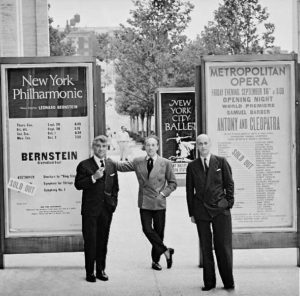 In 1966 the New York Philharmonic undertook an 18-day Stravinsky festival as a kind of try-out for Lukas Foss, whom Leonard Bernstein favored to take over as music director. The conductors included Foss, Bernstein, Ernest Ansermet (who had conducted for Diaghilev), Kiril Kondrashin (a major Soviet artist), and Stravinsky himself. George Balanchine choreographed Ragtime for Suzanne Farrell and Arthur Mitchell. The Soldier’s Tale was given with John Cage as the Devil, Elliott Carter as the Soldier, and Aaron Copland narrating. Elisabeth Schwarzkopf sang five Stravinsky songs, Pulcinella, an excerpt from The Rake’s Progress. Larry Rivers created a visual presentation for Oedipus Rex. Remarkably, the Stravinsky festival fizzled and Foss was passed over in favor of a French composer/conductor – Pierre Boulez – as much a stranger to Bernstein’s American agenda as to Indian ragas or Brazilian sambas.
In 1966 the New York Philharmonic undertook an 18-day Stravinsky festival as a kind of try-out for Lukas Foss, whom Leonard Bernstein favored to take over as music director. The conductors included Foss, Bernstein, Ernest Ansermet (who had conducted for Diaghilev), Kiril Kondrashin (a major Soviet artist), and Stravinsky himself. George Balanchine choreographed Ragtime for Suzanne Farrell and Arthur Mitchell. The Soldier’s Tale was given with John Cage as the Devil, Elliott Carter as the Soldier, and Aaron Copland narrating. Elisabeth Schwarzkopf sang five Stravinsky songs, Pulcinella, an excerpt from The Rake’s Progress. Larry Rivers created a visual presentation for Oedipus Rex. Remarkably, the Stravinsky festival fizzled and Foss was passed over in favor of a French composer/conductor – Pierre Boulez – as much a stranger to Bernstein’s American agenda as to Indian ragas or Brazilian sambas.
In 1972, across the Lincoln Center Plaza, New York City Ballet undertook a Stravinsky festival of its own. Balanchine’s company gave seven Stravinsky programs in eight days. Of 31 ballets presented, 21 were premieres. The eight Balanchine premieres included Violin Concerto, instantly recognized as iconic, and – on the same opening night — Symphony in Three Movements, which would take some years to register.
Comparisons to the Philharmonic’s Stravinsky festival six years previous were and are inescapable. The Philharmonic festival was bigger, with more big names and a fuller perspective on the Stravinsky odyssey — but was quickly forgotten. Obviously, the City Ballet festival enjoyed a creative component: the new ballets. Equally obvious was the difference in reception. For the Philharmonic subscribers, Stravinsky remained a chore. For patrons of City Ballet, Stravinsky was a privilege.
I tell this story in the course of a 10,000-word essay on arts leadership, written last year when I was a Resident Fellow at NYU’s Center for Ballet and the Arts. It’s currently posted on Doug McLennan’s invaluable artsjournal.com site, with five substantial responses – an “AJ Debate” itself linked to a recent “arts leadership” conclave at the University of Texas/El Paso.
A villain in my tale is Arthur Judson, for decades the major powerbroker for classical music in the US. Abdicating arts leadership (he even disfavored engaging a music director), Judson had for 34 years haphazardly fostered a faceless Philharmonic constituency. Balanchine and Lincoln Kirstein had since 1948 purposefully honed a validating cultural community. George Balanchine and City Ballet changed the face of dance. Leonard Bernstein led audiences to Mahler: he expanded the canon. But Bernstein could not change the face of the New York Philharmonic.
The starting point of my essay is an iconic 1966 photograph I remember from my teenage years. Balanchine, Bernstein, and Rudolf Bing, general manager of the Metropolitan Opera, are posed in front of Lincoln Center’s Philharmonic Hall. The Met is about to inaugurate its new home, completing the move to Lincoln Center of the three main institutional constituents. Bing stands alongside a poster brandishing the sold-out world premiere of Samuel Barber’s Antony and Cleopatra, inaugurating the New Met. Bernstein (with cigarette) stands alongside a poster showing the sold-out run of a subscription program comprising an obscure Beethoven overture, William Schuman’s String Symphony, and Mahler’s First (not yet a repertoire staple). A City Ballet poster, to the rear, announces the dates of the Fall season. So depicted, three performing arts leaders – all of them famously strong personalities — are seen poised to drive their celebrated companies to greater heights, buoying an unprecedented American cultural complex
Ten thousand words later, my essay ends:
“Lincoln Center was conceived by public-spirited corporate businessmen, led by John D. Rockefeller III. It never became a magnet for artists and intellectuals, humming with creativity, after the fashion of Harvey Lichtenstein’s BAM or Joe Papp’s Public Theatre. It has lately acquired a $1.5 billion facelift, including a dramatically thrusting façade for Alice Tully Hall and the Juilliard School; Tully itself, however, remains deficient in the intimacy and warmth appropriate to a chamber-music venue.
“Imagine, if you can, a photograph of Peter Gelb, Alan Gilbert, and Peter Martins posed in front of the new, glass-enclosed Tully complex. All three institutions are poised to collaborate on a multi-week festival addressing pressing contemporary social and political issues, with the full participation of the New York City public schools and the City University of New York (whose Hunter College Auditorium will reportedly host the Philharmonic during Geffen Hall renovations).”
I cited this pipedream because I knew it would be realized this February in the city of El Paso, where a “Copland and Mexico” festival, supported by the National Endowment for the Humanities, would celebrate cultural collaboration between two nations embroiled in an uncertain future relationship. Mexico’s amazing artistic efflorescence of the 1930s – today mostly unremembered by young Mexican-Americans – would be the central topic.
A centerpiece of the programing would be the iconic film of the Mexican Revolution: Redes (1935), which thrillingly combines the talents of a master (and under-recognized) Mexican composer — Silvestre Revueltas — and a legendary American photographer – Paul Strand. The participating institutions would include the El Paso Symphony Orchestra, the El Paso public schools, and the University of Texas/El Paso (UTEP), with classes and faculty members in half a dozen departments taking part. The festival would penetrate outlying “colonias” without paved roads or running water, and also the neighboring Mexican city of Juarez. The many scheduled events would include “Copland and the Cold War” – an evening of music and theater exploring the impact of the Red Scare on America’s most prominent composer of concert music. It all duly transpired a week ago.
What I could not anticipate was the pertinence of the El Paso festival to arts leadership in the age of Donald Trump – the inevitable focus of the artsjournal conclave in El Paso on Feb. 17. The participants, in addition to Doug and myself, were two bona fide arts leaders: Frank Candelaria, UTEP’s missionary Associate Provost, and Delta David Gier, music director of the unique South Dakota Symphony – whose Lakota Music Project I have extolled in this space. You can watch the conclave here. The talks are 20 minutes each. They tell stories — about how the arts can impact on the way we live, and on individual lives — that need to be heard, and never more than now.
February 27, 2017
AT THE BARRICADES: The Arts in the Age of Trump
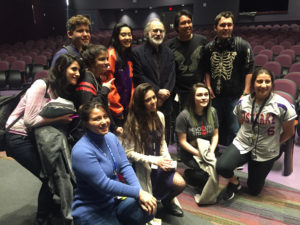 You’re looking at a photo of me – the old guy with the beard – being thanked by students at East Lake High School, a semi-rural public high school on the outskirts of El Paso, Texas. Five hundred East Lake students had just spent 90 minutes watching and listening to a presentation sampling Redes (1935) – the iconic film of the Mexican Revolution, a tale of exploited fishermen who unite and revolt.
You’re looking at a photo of me – the old guy with the beard – being thanked by students at East Lake High School, a semi-rural public high school on the outskirts of El Paso, Texas. Five hundred East Lake students had just spent 90 minutes watching and listening to a presentation sampling Redes (1935) – the iconic film of the Mexican Revolution, a tale of exploited fishermen who unite and revolt.
As readers of this blog know, Redes is an obsession of mine. However little acknowledged, it’s one of the peak examples, in all cinema, of great music wedded to great cinematography. As the composer is Silvestre Revueltas, and the cinematographer Paul Strand, Redes also documents a historic Mexican/American collaboration during a decade when Diego Rivera’s Mexico exemplified how artists and intellectuals could power social change. Here’s a galvanizing Redes sequence: the funeral of a child.
For Naxos, my DC-based PostClassical Ensemble (I’m Executive Director) has produced a DVD mating Redes to a freshly recorded soundtrack. It’s that DVD that I sampled for the East Lake students as part of a week-long El Paso festival, “Copland and Mexico.” As I’ve previously written, El Paso (about 80 percent Hispanic) is an ideal incubator for impactful art.
“Copand and Mexico” is a product of Music Unwound, the NEH-supported national consortium of orchestras, festivals, and universities that I direct. In El Paso, the festival included (among many other activities) three screenings of Redes with live accompaniment by the El Paso Symphony. The third of these was a free performance in neighboring Juarez, Mexico. The Juarez audience was unlike any I have previously witnessed at a symphonic performance. Many families attended. The hall – an exemplary 10-year-old facility on the campus of the university – was full of children. Everyone was raptly attentive. I have little doubt that for many of those who came, the story of the cultural efflorescence that drew Copland, Strand, Steinbeck, Eisenstein, and Langston Hughes to Mexico – a phenomenon concurrently explored in many classrooms at the remarkable University of Texas/El Paso — was a revelation.
The El Paso “Copland and Mexico” festival was covered by Armando Trull of National Public Radio. He filed two stories: one on NPR, another for The Huffington Post. The interviews included one with a fifteen-year old who attended a Redes presentation at Tornillo High School. Thirty miles south of El Paso, Tornillo (population 3,000) is a “colonia.” So is East Lake — certified by the State of Texas as “a residential area along the Texas-Mexico border that may lack some of the most basic living necessities, such as potable water and sewer systems, electricity, paved roads, and safe and sanitary housing.” The young man in Tornillo told Trull: “It’s important [for us] to know that there are Mexican composers and artists who became successful.” Tornillo students were bussed to the El Paso Symphony concert.
Trull’s story instantly provoked a listener response on the NPR site. It read:
“Propaganda festival. Get rid of the National Endowment for the Humanities. Totally unnecessary government office. If you want to talk about the contributions of Mexicans, you need to cover the whole spectrum. 7 out of 10 federal foreign prisoners in this country are from Mexico. Their welfare usage rates are much higher than the general population and their tax contributions are significantly lower. Mexican immigrants (legal and illegal) drive down wages for American workers. Billions of dollars of drugs (and associated crime) pour across the Mexican border every year, which is tragically killing our young people and destroying our society.”
In fact, far from being conceived as a propaganda instrument challenging our new President, the Music Unwound “Copland and Mexico” presentation – a multi-media exegesis with an actor, an orchestra, and a continuous visual track additional to Redes — originated in 2012. The first consortium participant was the Louisville Orchestra. From there “Copland and Mexico” was taken up by the Austin Symphony, the North Carolina Symphony, and the Buffalo Philharmonic. The script used in El Paso was verbatim what I wrote five years ago in the conviction that culture can be a potent tool for human betterment and mutual understanding.
I have never been more convinced of that than I am today.
“Copland and Mexico” will next travel to the New Hampshire Music Festival, then the Las Vegas Philharmonic, then the South Dakota Symphony, then the Brevard Music Center. Its pertinence will not fade. Check out the eyes of the East Lake students in the photo below. They are discovering Redes.
(Please note that the views expressed by this posting do not necessarily represent those of the National Endowment for the Humanities.)
February 26, 2017
Are Orchestras Better than Ever? Why Riccardo Muti is Wrong
Are orchestras better than ever? Riccardo Muti thinks so. Recently, dedicating a bust of Fritz Reiner at Chicago’s Orchestra Hall, he said: “The level of the orchestras in the world – especially in the seventies and eighties — has gone up everywhere.”
What is Muti talking about? I suppose he’s applying the criterion of perfection. Perfect intonation, perfect ensemble. What kind of criterion is that?
Thanks to the exceptional WWFM The Classical Network, I’ve been able to respond to this parochial claim at three hours length, in colloquy with Bill McGlaughlin. You can hear the resulting rant here and here. Bill and I auditioned fabulous concert and studio recordings by Leopold Stokowski and the Philadelphia Orchestra, Serge Koussevitzky and the Boston Symphony, Dmitri Mitropoulos and the Minneapolis Symphony, Arturo Toscanini and the New York Philharmonic, Artur Bodanzky and the Metropolitan Opera Orchestra, and Evgeny Mravinsky and the Leningrad Philharmonic.
Three things bear mentioning about these historic pairings. The first is that – to a degree unknown today – the conductors stayed put. There were no airplanes. The music director was the music director.
The second thing that leaps to mind – and to the attentive ear – is that each of these conductors honed a distinctive sonic imprint. No one could possibly mistake a Stokowski orchestra for a Mitropoulos orchestra.
Thirdly, each of these conductors pursued a distinctive mission allied with repertoire. Except in the cases of Bodanzky and Toscanini, the espoused repertoire was fresh.
Take Koussevitzky in Boston (a 25-year tenure). He gave the American premiere of Ravel’s orchestration of Mussorgsky’s Pictures at an Exhibition. He gave the world premiere of Bartok’s Concerto for Orchestra. What is more, he commissioned both these famous compositions. His Boston broadcasts capture the most galvanizing readings of both pieces I have ever heard. Bill and I listened to them together. You can hear Koussevitzky’s indescribably hot Mussorgsky/Ravel at 51:40 here – after which I exclaimed “Give me a break! You can’t possibly tell me orchestras are better than ever!”
Then there is Mitropoulos in Minneapolis – an extremist, the Dr. Caligari of the podium. This was an orchestra whose concertmaster, Louis Krasner, had premiered the Berg and Schoenberg concertos. Its stylistic base was Mahler and the Second Viennese School. In 1940 Mitropoulos made the first and best recording of Mahler’s First Symphony. Check it out at 10:16 here. If Mitropoulos (as I argue, citing evidence) conducts Mahler a la Mahler, his Schumann Second Symphony a la Mahler is an acquired taste. Bill (at 32:38) was bewildered: “It makes me really jittery. I can’t understand this Schumann. I know that Schumann was meshugana. It’s almost like an Expressionist Schuman . . . this is so crazy-making for me. Help me out!”
The larger premise of this three-hour harangue is that nothing like the bristling sense of occasion once registered by Koussevitzky and Mitropoulos – or by Bodanzky’s powderkeg of a pit orchestra, so much more distinctive than the generic Met Opera orchestra of today – can any longer be assured. The concert experience needs to be refreshed and rethought. That’s the premise of PostClassical Ensemble, the DC-based chamber orchestra I co-founded with Angel Gil-Ordonez 14 years ago.
In April, WWFM inaugurates “PostClassical,” a series of two-hour thematic specials culling live and recorded PCE performances. We begin by celebrating the Lou Harrison Centenary on April 28. In June, we argue that Bernard Herrmann was the most underrated American composer of the 20th century. Others shows in the series will include “Schubert Uncorked” (with bass trombonist David Taylor), “Stravinsky and Shostakovich Reconsidered (with pianist Alexander Toradze), “Dvorak and Hiawatha,” and “Silvestre Revueltas: Better than Copland.”
Stay tuned.
February 6, 2017
Music and the National Mood
PostClassical Ensemble – the DC chamber orchestra I co-founded a dozen years ago – produced a concert at the Washington National Cathedral last Saturday night that seemed to address the national mood. These are fractious times – times in which the arts can acquire a special pertinence. Times in which music can be a provocation or a balm.
We titled our program “The Trumpet Shall Sound.” It intermingled spirituals with religious arias by Bach, Handel, and Mendelssohn. Our inspiration was the example of Harry Burleigh – who more than anyone else was responsible for transforming spirituals into art songs.
Burleigh – once Dvorak’s assistant at New York’s National Conservatory (1892-1895) — is a forgotten hero of American music. His seminal “Deep River” arrangement of 1915 electrified American audiences; it was instantly appropriated by preeminent white recitalists. It was later sung by Marian Anderson and Paul Robeson. It is still sung today.
Burleigh’s own recital repertoire also included songs by Beethoven, Faure, Grieg, Mendelssohn, Schubert, Schumann, and Tchaikovsky. Mendelssohn’s Elijah was a Burleigh specialty. Doubtless for Burleigh all this music spoke a common language of uplift.
Our soloist at the Washington Cathedral was the African-American bass-baritone Kevin Deas. I would say that he is today’s supreme exponent of spirituals in concert. He made his early career singing Bach and Handel. He came relatively late to Burleigh’s spiritual arrangements. For him the distance from Messiah to “Go Down, Moses” is inconsequential.
It has been my privilege to accompany Kevin Deas in concert for the past decade – but never before in such a vast and inspirational space. Burleigh himself advised that “success in singing these Folk Songs is primarily dependent upon deep spiritual feeling.” Kevin possesses a divinely mellifluous instrument (an audience member at one of our concerts confided, weeping, that she felt she had heard “the voice of God”). But his performances begin not with notes; they begin with with feeling. I know from experience with other singers that an iota of ego is fatal in this repertoire. At the National Cathedral, the gravitas of the space informed all we did. My sense, on stage, was that the evening’s eighth number, Burleigh’s voice-and-piano arrangement of “Steal Away,” hypnotized the big room for good (the nave held nearly 1,000 listeners). It sounded like this.
After that, seamlessly (we proceeded without applause), came Nathaniel Dett’s galvanizing “Listen to the Lambs” with the Cathedral Choir, then Kevin Deas singing “For the Mountain Shall Depart” from Elijah, with PostClassical Ensemble led by Angel Gil-Ordonez. The evening built to Burleigh’s classic “Deep River” for mixed a cappella chorus, followed by two Messiah selections: “The Trumpet Shall Sound” and the Hallelujah Chorus.
But if there was a signature number, it may have been William Dawson’s arrangement of “There is a Balm in Gilead” – a piece Leontyne Price used to sing. Many with whom I spoke afterward had found the evening a necessary balm.
During the Cold War, the Kennedy White House famously hosted culture. JFK would talk about how the arts can only thrive in a harmonious “free society.” That was either naïve nonsense or cynical propaganda. The arts thrive in exigent times. In the twentieth century, the thirties and the sixties – the Depression, the Vietnam years — were decades remarkable for American artistic expression, decades in which music memorably voiced protest and compassion.
We may well be embarking on another such trying period in our nation’s history. In what ways will our musical institutions rise to the occasion? We shall see.
Joseph Horowitz's Blog
- Joseph Horowitz's profile
- 17 followers


